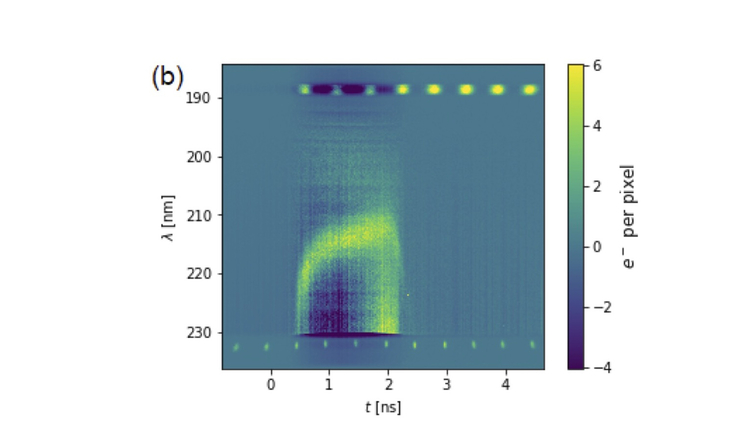Scientists reject restrictive heat flux models using directly driven gold spheres
 (Download Image)
(Download Image)
This image shows the spectral feature from the optical Thomson scattering diagnostic that is used to infer density and temperature. This feature appears due to laser light scattering off background density fluctuations in the plasma.
A team of scientists have conducted an analysis of directly driven gold sphere experiments to test heat transport models used in inertial confinement fusion (ICF) and high energy density (HED) modeling. It was found that overly restricting the heat flux caused disagreement with measurement.
However, simulations with a reduced nonlocal heat transport model quantitatively matched the plasma conditions (both electron density and temperature) inferred from the optical Thomson scattering diagnostic, and that the plasma conditions were qualitatively consistent with a local, unrestricted heat transport model. Further, disagreements in laser coupling and radiated power are likely due to deficiencies in models of other physical processes.
This work was presented as an invited talk at the 2020 APS Division of Plasma Physics meeting, and it appears in Physics of Plasmas in the "Special Collection: Papers from the 62nd Annual Meeting of the APS Division of Plasma Physics." The work is a product of a collaboration between Lawrence Livermore National Laboratory (LLNL), the Laboratory for Laser Energetics and the University of Alberta. The experiment was conducted at the Omega Laser Facility at the University of Rochester.
Will Farmer from LLNL served as the lead designer and first author of the paper, and George Swadling was the lead experimentalist and co-author. Additional co-authors include Mordy Rosen, Candace Harris, Marilyn Schneider, Mark Sherlock and Steven Ross from LLNL, Wojciech Rozmus and Colin Bruulsema from the University of Alberta and Dana H. Edgell and Joe Katz from the University of Rochester.
"We were unable to match the measured unabsorbed laser light and radiated X-ray flux, but the plasma conditions were insensitive to the energy discrepancy for these processes," Farmer said of the work. “This suggests that deficiencies in the modeling are not due to heat transport but some other piece of physics.”
This research was conducted in an effort to determine the source of the “drive-deficit,” a long-standing problem in ICF and HED modeling whereby capsule bang-times always seem to occur later than in simulations and the amount of X-ray flux in a hohlraum is over-predicted by simulation.
Previously, it had been proposed that using a restrictive heat flux model could eliminate part of the drive-deficit. The gold sphere results do not support this approach and suggest that the problem is elsewhere. Solving the drive-deficit issue is an important step toward developing a predictive model of ICF and HED experiments.
Farmer compared energy balance in a hohlraum to cooking a cake in an oven. “You’ve put your cake in the oven,” he said. “And you want to know when you have to take it out. In order to know, you need to understand how much energy you’re putting into the oven, how much energy is reflected by the walls and how much energy is lost via conduction out of the walls, so that your estimate of the oven temperature is correct.”
Farmer said that for whatever reason, the oven is cooler than we think it should be and the cake always seems to take longer to cook than we think it should, and this work is trying to figure out why the oven is "leakier" than expected. “We’ve determined that heat transport, at least for directly driven gold spheres. No one wants a runny cake,” he explained.
Farmer said the work sits at the heart of the stockpile stewardship mission for the Lab, because it is attempting to develop predictive tools that can be applied throughout the HED and ICF communities. “I think that if we can understand the drive-deficit, it will have profound implications for many different active areas of research at the Laboratory,” he said.
Farmer said that since the team has concluded that the problem is not heat transport, the next step is to examine other possible physical mechanisms. First, they want to examine whether they can match both the plasma conditions and the laser coupling using the best laser plasma interaction codes for low Z, beryllium spheres where little energy is partitioned into X-rays. Then the team will take what is learned and apply it to gold spheres to see if there is a self-consistent story for both laser coupling and heat transport, with any further discrepancy likely attributable to deficiencies in the modeling of atomic physics processes.
Second, the team has put in a proposal to do mid-Z spheres, where radiation has a moderate impact on the energy balance. There, the researchers can test if the discrepancy in simulated energy balance is due to the atomic physics predictions of X-ray opacities and emissivities.
Farmer said LLNL has built a strong collaboration with Rozmus and his graduate student Bruulsema who were instrumental in analyzing the data for the work. Two publications have come out of this project so far and a third is being written. Additional publications are expected as work continues.
Contact
 Michael Padilla
Michael Padilla
[email protected]
(925) 341-8692
Related Links
Physics of PlasmasLaboratory for Laser Energetics
University of Alberta
Omega Laser Facility
Tags
PhysicsLasers and Optical S&T
Lasers
National Ignition Facility and Photon Science
Physical and Life Sciences
Featured Articles







